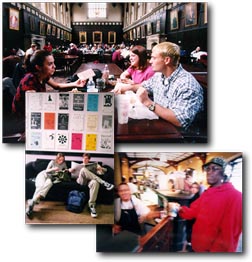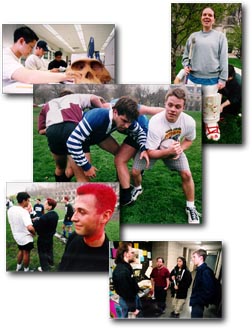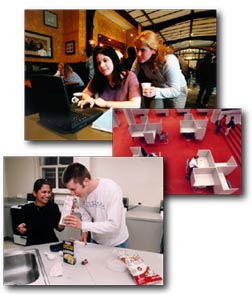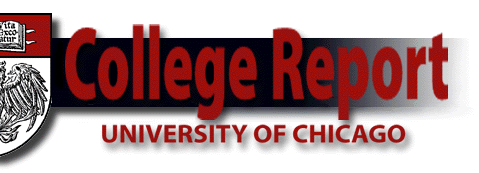 |
 Meanwhile,
in the top-floor University Theater lounge, Cassie Bissell, a third-year
gender studies concentrator, shows off the recent redecoration of
the attic-like space, painted in two tones of lavender and covered
with at least five years’ worth of performance posters. Irene
Hodes, a second-year concentrating in general studies in the humanities,
plugs her directorial adaptation of Tony Kushner’s A Bright
Room Called Day, scheduled to run during the ninth week of spring
quarter. Sinking into a secondhand sofa, second-year anthropology
concentrator Jenny Connell reads Illness as Metaphor
and AIDS and Its Metaphors by Susan Sontag, AB’51. Next
to her, Josh Knorr, a third-year Law, Letters, & Society
concentrator, opens the free press to the Behnke interview. Meanwhile,
in the top-floor University Theater lounge, Cassie Bissell, a third-year
gender studies concentrator, shows off the recent redecoration of
the attic-like space, painted in two tones of lavender and covered
with at least five years’ worth of performance posters. Irene
Hodes, a second-year concentrating in general studies in the humanities,
plugs her directorial adaptation of Tony Kushner’s A Bright
Room Called Day, scheduled to run during the ninth week of spring
quarter. Sinking into a secondhand sofa, second-year anthropology
concentrator Jenny Connell reads Illness as Metaphor
and AIDS and Its Metaphors by Susan Sontag, AB’51. Next
to her, Josh Knorr, a third-year Law, Letters, & Society
concentrator, opens the free press to the Behnke interview.
In their own cluttered office, two Student Government members assess
the previous day’s “Fun-In,” where students offered
free pizza on the quads in front of the Administration Building
and raised concerns about issues ranging from student health insurance
and housing to changes in the Common Core. Amid leftover flyers
and posters, fourth-year Abby Chua, the SG vice president of student
affairs and a Law, Letters, & Society concentrator, says that
by co-sponsoring the “Fun-In” with about 14 other groups,
SG hoped to “foster student involvement in the process of changes
under way at the University, raise awareness among students, and
prompt discussion.”
Nearing the start of afternoon classes, the C-Shop’s Shake
Day line grows. Taking advantage of the traditional $1 Wednesday
deal, Monzia Moodie, a second-year chemistry concentrator,
orders a chocolate-chip-cookie-dough milk shake topped with the
works—wafer, whipped cream, and cherry. He’s followed
by two varsity softball teammates, first-year catcher Jen DeLopst
and fourth-year center fielder and economics concentrator Amy Still.
DeLopst downs a mint-chocolate-chip shake en route to her job in
a gene-mapping lab, as Still opts for cookies-and-cream before heading
off to econ. “Coach will just love that this is our lunch!”
laughs Still.
While the morning on campus may have been devoted to a collective
awakening, the afternoon finds College students engrossed in their
work, spending hours in the studio or lab.
 Across
a Midway soggy from the night’s rains, 20 undergraduates gather
in Midway Studios at 1:30 p.m. for Advanced Sculpture 282
with Herbert George, an associate professor in the Committee on
the Visual Arts. The studio—a year-round winter of white dust,
paint, and plaster—takes on an ethereal quality in the muffled
light of the graying day. The students present their latest creations,
referring to a list taped to a door of 14 “Elements of Sculpture,”
which include mass, surface, and scale. George gently prompts a
debate over what the students’ nonrepresentational sculptures
may, in fact, represent. He then leads the class outside to view
a sculpture composed of a winding, vertical succession of metallic
circles. Elodie Guez, a second-year art and English concentrator,
slips out early to make it to Gothic Anglo-American literature.
Gathering her portfolio, she allows of the art class: “We’re
a small group, but we all love it. We’re really into it. This
is a break in my day.” Across
a Midway soggy from the night’s rains, 20 undergraduates gather
in Midway Studios at 1:30 p.m. for Advanced Sculpture 282
with Herbert George, an associate professor in the Committee on
the Visual Arts. The studio—a year-round winter of white dust,
paint, and plaster—takes on an ethereal quality in the muffled
light of the graying day. The students present their latest creations,
referring to a list taped to a door of 14 “Elements of Sculpture,”
which include mass, surface, and scale. George gently prompts a
debate over what the students’ nonrepresentational sculptures
may, in fact, represent. He then leads the class outside to view
a sculpture composed of a winding, vertical succession of metallic
circles. Elodie Guez, a second-year art and English concentrator,
slips out early to make it to Gothic Anglo-American literature.
Gathering her portfolio, she allows of the art class: “We’re
a small group, but we all love it. We’re really into it. This
is a break in my day.”
There’s art and creation of a different bent to be found at
the five-year-old Donnelley Biological Sciences Learning Center—whose
modernity offers a stark contrast to Midway Studios, a National
Historic Landmark.
Along one of the BSLC’s many corridors hang Arthur Lidov’s
paintings Biological Clocks and The Digestive System.
In one spotless room, about 20 students construct scientific family
trees during their three-and-a-half-hour lab for Ecology/Genetics/Evolution
192, the lecture class of John Flynn, the Field Museum’s
MacArthur curator and the associate chair of the University’s
Committee on Evolutionary Biology. Huddled around Macintosh screens,
first- and second-years enter characteristics of sundry mammalian
skulls into a computer program. They’ll use the program to
create a matrix that will help them form hypotheses of evolutionary
relationships among different species, explains teaching assistant
Karen Koeninger Ryan, SM’97, a biological sciences graduate
student. Later, she says, they will compare the species using molecular
data.
In the late afternoon, students emerge from their cloisters. Despite
a return of clouds and chilly winds, dozens head to the Midway to
let off some steam.
During a muddy practice of the rugby club, third-year Marc
Skeist, an anthropology concentrator, plays the lock position,
while second-year Bill Sensakovic, a physics and math concentrator,
tries to hold onto the ball as a wing. The women’s ultimate
Frisbee club team sends disks sailing as the men’s team stretches.
In front of Harper Library, not far from the bronze statue of Linnaeus,
first-year Kate Lister suits up to play goalie for the field
hockey club team, with help from teammate Nina Wu, a second-year
“psych or international studies” concentrator, and coach
Pat Sayre-McCoy, a Law School librarian. On the next rectangular
patch of green, an independent team known as the Hitmen, with hair
dyed red for the occasion, defeat Dodd-Mead House’s Soccer
Hooligans 2-0 in intramural soccer. Dye runs in rivulets of sweat
down the neck of fourth-year economics concentrator Bruno Raposo
as he walks off the field.
 It’s
now 4:30 p.m. The sun shines through the clouds as it starts a slow
drop over the quads. Back in the C-Shop, first-year Jennifer
Berg sets up her laptop to work on an art-history paper that,
according to her assignment memo, must be about “any Chinese
object from the Song (960–1279) through Qing (1644–1912)
dynasties.” Pierce Hall dormmate Colleen Peterson, a
second-year English concentrator, checks out the laptop before heading
back downstairs to work on the Chicago Weekly News, a student-run
newspaper. It’s
now 4:30 p.m. The sun shines through the clouds as it starts a slow
drop over the quads. Back in the C-Shop, first-year Jennifer
Berg sets up her laptop to work on an art-history paper that,
according to her assignment memo, must be about “any Chinese
object from the Song (960–1279) through Qing (1644–1912)
dynasties.” Pierce Hall dormmate Colleen Peterson, a
second-year English concentrator, checks out the laptop before heading
back downstairs to work on the Chicago Weekly News, a student-run
newspaper.
Across the quads at the Albert Pick Hall for International Studies,
a Kosovo teach-in organized by graduate students starts to break
up. It’s been nearly a month now since NATO began bombing in
the Balkans. In the Pick lobby, second-year Andrea Pastor,
who’s concentrating in psychology and English and is a member
of the campus chapter of the War Resisters League, talks about upcoming
events with other activists, including first-year Peter Frase.
“Besides my opposition to war in general, I believe that
the humanitarian pretext for intervening in the Balkans is false,”
says Frase, who’s wearing a backpack. “The reason for
the intervention has to do with NATO wanting to exert its influence
in the region.”
At 6 p.m., everyone seems to be scurrying in the direction of food.
A few blocks northwest of campus, resident head Jane E. Barden,
AM’91, returns to Maclean House after walking her two chocolate
Labradors—Jofi and Elwood Bluesdog—with third-year Sabrina
Saraf, an economics concentrator. In the lobby, all four shake
drops of drizzle from their coats. Then Saraf and first-year John
Flack head up to Maclean’s communal kitchen, equipped with
six stoves, four sinks, two industrial-size refrigerators, a large
freezer, three microwaves, and 100 storage lockers. Both sniff the
milk for freshness before Saraf christens a pot—bought with
Barden on an afternoon jaunt to Kmart—with Kraft white-cheddar
macaroni-and-cheese. Flack prepares a bag of Wei-Chuan vegetable-and-pork
dumplings.
On the walk back to the central campus, flashes from an approaching
storm backlight Hitchcock Hall. The Reg is refuge for second-year
Liz Corken, a psychology concentrator, who reads John Stuart Mill’s
Subjection of Women for a social-sciences core class. A floor
below, second-years Stephenie Takahashi, a biology concentrator,
and ponytailed Rachel Knipe, a chemistry concentrator, read
Mill as well.
Outside the Reg’s east entrance, it’s the kind of night
when it wouldn’t be surprising if the campus gargoyles took
flight. The eerily quiet sky takes on a purplish-blue hue, carving
a chalk-white silhouette in stone of Bartlett Gymnasium. The Tribune’s
prediction of “a stormy mid-continent clash” of “dueling
air masses” appears to have been all too accurate.
If the gargoyles did swoop down, they would fly to the equally
dramatic music coming from Mandel Hall. Under the direction of conductor
Barbara Schubert, the 100-piece University Symphony Orchestra rehearses
William Walton’s Belshazzar’s Feast for a reunion
weekend concert. Assistant concert master Anna Naples, a third-year
anthropology concentrator, plays her violin across the stage from
her fiancé, fourth-year biology concentrator Johann Ohly,
who plays the Testore reserved for the orchestra’s principal
cellist. Along with the other musicians—many in sleeveless
shirts and sandals—they perform for an audience of strewn-about
coats and empty instrument cases. But, eyes closed, it’s not
hard to imagine an orchestra of pressed jackets and shined shoes
and a packed house full of ball gowns and tuxedos.
Perhaps a sequel titled “A Night in the Life of the College”
is called for. When the Magazine’s 12-hour walk ends
at 8 p.m., the campus grounds grow darker and quieter just as more
rooms in more buildings brighten. At Ida Noyes, the evening’s
schedule lists a rehearsal of the UC Dancers, a meeting of the science
fiction club, and a DOC Films showing of Raging Bull. The Reynolds
Club’s Wednesday night slate includes meetings of the Swahili
Circle language club, the SG, the South Asian Students Association,
and the Glass Eyeball photography club.
Later, the dorms will likely be full of students reading one last
chapter, writing one last paragraph, or checking one last e-mail
before going to bed. The lights will finally go out long after the
Magazine has closed its notebook and capped its lens—and, in
some cases, about the time Gwen McCoy starts heating up tomorrow’s
breakfast tacos.
|

